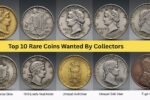For over a century, the Lincoln Wheat Penny has been one of the most collected coins in American history. Minted from 1909 to 1958, these copper classics continue to capture the imagination of both casual collectors and serious numismatists. Over the past 13 years, their value has fluctuated dramatically — with some rare editions selling for tens of thousands or even millions of dollars. This guide explores how Wheat Penny values have evolved and why they remain a dream for coin enthusiasts.
A Brief History of the Lincoln Wheat Penny
The Wheat Penny was introduced in 1909 to honor the 100th birthday of President Abraham Lincoln. Designed by Victor David Brenner, it replaced the Indian Head cent and featured Lincoln’s portrait on the obverse and two wheat ears on the reverse — symbolizing prosperity and national strength.
Production continued until 1958, when the design was replaced with the Lincoln Memorial reverse in 1959.
$2,000 Direct Deposit for US Citizens – Check Eligibility, Payment Schedule & IRS Rules
Wheat Penny Value Trends (2012–2025)
The value of Wheat Pennies has seen a steady rise since 2012, driven by increasing collector demand and discovery of rare varieties:
2012–2015:
-
Common dates (1940s–1950s) sold for 2–5 cents each in circulated condition.
-
Rare coins like the 1909-S VDB and 1914-D were worth $500 to $2,000 in fine condition.
2016–2019:
-
Online auction platforms boosted visibility, and certified high-grade coins saw big jumps.
-
1943 copper pennies (error coins) fetched over $100,000 at auctions.
2020–2023:
-
Pandemic-era coin collecting surged as a hobby, increasing prices further.
-
The 1909-S VDB in mint state condition surpassed $5,000–$10,000.
-
Some extremely rare Wheat Pennies with minting errors sold for over $1 million.
2024–2025:
-
As of 2025, rare and certified coins remain highly sought after.
-
Common Wheat Pennies in average condition still trade for a few cents, but pristine or error varieties can reach six- to seven-figure prices.
The Most Valuable Wheat Pennies
Here are some standout examples of Wheat Pennies that have made headlines:
-
1909-S VDB: The first-year issue from San Francisco — worth up to $10,000+ in mint state.
-
1914-D: A low-mintage Denver coin valued between $1,500–$25,000.
-
1922 No D: A Denver mint error missing its mint mark — up to $20,000.
-
1943 Copper Penny: Struck on bronze instead of steel — worth $100,000 to over $1 million.
-
1955 Double Die Obverse: Famous for its dramatic doubling of the date and lettering — valued from $1,500–$50,000.
Why Values Keep Rising
-
Rarity: Low-mintage and error coins continue to disappear into private collections.
-
Condition: High-grade or uncirculated pennies are increasingly scarce.
-
Historical Significance: Collectors love owning a piece of early 20th-century Americana.
-
Online Awareness: Social media and coin-collecting forums have reignited public interest.
How to Check If You Have a Valuable Wheat Penny
-
Look for key dates like 1909-S, 1914-D, 1922, 1943, and 1955.
-
Check mint marks — “S” (San Francisco) and “D” (Denver) are often rarer.
-
Inspect for minting errors such as double dies, off-center strikes, or missing details.
-
Use magnification to examine details on the coin’s surface.
-
Get it professionally graded by PCGS or NGC to confirm authenticity and condition.
Final Thoughts
The Lincoln Wheat Penny continues to be a gateway to coin collecting — a simple piece of copper that connects everyday Americans to history. Whether you find one in your change jar or inherit a family coin box, each Wheat Penny holds a story.
As the last 13 years have shown, even the smallest coin can become a collector’s dream. So before you spend that old penny, take a closer look — you might just be holding a fortune.
FAQ – Wheat Penny Value Guide (2012–2025)
Q1: Are Wheat Pennies still in circulation?
A: While extremely rare, some Wheat Pennies do still appear in circulation, especially from the 1940s and 1950s.
Q2: What makes a Wheat Penny valuable?
A: Key dates, mint marks, minting errors, and condition all play a role in determining value.
Q3: What is the most valuable Wheat Penny ever sold?
A: A 1943 bronze Wheat Penny sold for over $1.7 million at auction.
Q4: How can I tell if my Wheat Penny is rare?
A: Look for early dates, “S” or “D” mint marks, or noticeable minting errors like doubling or missing details.
Q5: Should I clean my Wheat Pennies?
A: Never clean coins — it can damage the surface and drastically reduce value.
Q6: Where can I sell valuable Wheat Pennies?
A: Sell through reputable coin dealers, numismatic auctions, or certified grading services such as PCGS or NGC.






